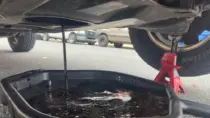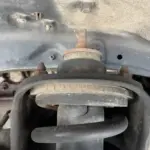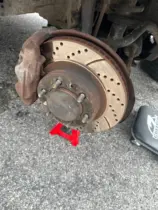Zen and the Art of the FJ Cruiser Oil Change

Two months, 5,000 worry-free miles, time for the first FJ Cruiser oil change. Warm it up, drop the plug, swap the filter, fresh crush washer; nothing that earns a merit badge.
The only surprises were the honest ones: two torn inner CV boots and the reminder that trucks tell the truth long before the sales brochures.
FJ Cruiser Oil Change: Kneeling at the 5,000 Mile Altar
The drain stream looked like strong coffee and the filter surrendered like it had somewhere else to be. Top up with fresh 5W‑30, check for leaks, done.
Somewhere between the drain plug and the dipstick I spotted CV grease flung like confetti.
Add it to the list, but the next few Saturdays are spoken for.
Old trucks are simple that way: feed them boring maintenance and they repay you with more interesting miles than you have any right to.
What oil weight?
Toyota recommends SAE 5W-30 for the 1GR-FE
Five Quarts and a Quiet History Lesson

As I lay there on my back, staring at the Cruiser’s underbelly, the grease, oil, and hot engine smells brought me back.
I grew up behind GM parts counters; my dad worked for GM for 20+ years during the now infamous “malaise era.” The Buy American chorus trumpeted from every terrestrial radio station and between every prime-time TV show.
I knew bone deep: trucks with bow-tie emblems were the best.
Later I learned those opinions ship with hidden dealer costs: a tariff with a barnyard nickname pecking at truck choices since the ’60s, “voluntary” limits on car imports from Japan in the ’80s, and ad men who deftly disguised consumerism as patriotism.
None of it is scandal; it’s stagecraft. You’re just part of the planned suburban furniture until you bring a different rig to the show.
The FJ is that different rig. It doesn’t argue. It just starts, shrugs at mileage, and behaves with better manners than man’s best friend… sorry, Hugo.
How much oil do I need for my FJ Cruiser oil change?
Have 6 quarts on the bench; you’ll use about 5.5 quarts with a new filter.
Slogans sell trucks. Loyalty is earned in miles, not marketing.
What the FJ Cruiser Oil Change Actually Told Me

Post‑oil change crawl around: bushings with tasteful crow’s‑feet, hardware where Toyota left it, CV boots officially on the to‑do list.
The message was simple: keep up the mundane maintenance and I’ll handle the adventurous bits. Fair trade.
One curiosity from the crawl around: the previous owner fitted drilled and slotted rotors up front. They stop fine, but they’re not my forever plan.
That rant gets its own post; for now, call them temporary tattoos on the front hubs.
From 0-60 to 4-Low
I used to memorize 0-60 times and horsepower numbers. I drooled over Motown metal from the 50’s and 60’s and imagined building my own sleeper project.
These days I prefer the quiet satisfaction of picking a line, letting the truck do its clever little traction trick, and showing up for Monday morning school drop-off like nothing happened.
The FJ excels at that kind of competence. It asks for oil on schedule and patience for aging rubber. In return, reliability becomes a personality trait.
How tight should I make the lugs after rotating the tires?
Toyota recommends 85 ft-lb or 113 N-m
Why Toyota?
No conversion therapy, no celeb-studded ad campaign. Just a machine that rewards attention.
If there’s a moral, it’s this: maintain the truck you have, doubt the stories you inherited, and let experience pick your team. The rest is shop towels, torque specs, and flashing MAINT REQD lights.
Be Part of the Conversation
If you defected from one badge to another, tell me what converted you. Or share what runs through your mind while you’re turning wrenches.
Until next time, I’ll be under the truck plotting a CV reboot and pretending drilled rotors add horsepower.
Just the Specs
| Item | Spec |
|---|---|
| Engine Oil Grade | ILSAC multigrade, SAE 5W-30 (I use Valvoline Restore & Protect [*Affiliate Link]) |
| Capacity (drain & refill) | 5.5 qt (5.2 L) with filter; 5.2 qt (4.9 L) without. |
| Drain plug torque | 30 ft-lb (40 N-m). |
| Oil filter (’07-’09) | Spin-on Toyota 99015-YZZD3 [*Affiliate Link] (OE). |
| Maintenance reminder reset | Odometer showing -> key to ACC/LOCK – hold trip reset -> key to ON while holding -> bars count down to “000000” -> release; light goes off. |
| Wheel lug nut torque | 85 ft-lb (113 N-m) (handy if you rotate tires). |
| TRD front skid-plate bolts | 22 ft-lb (30 N-m) (if you have one of those) |
Step-by-Step
- Warm it up. Three to five minutes brings the oil from maple syrup to pour-over. Shut it down.
- Open the stage. Drop the little service door or the front skid (Mine doesn’t have the service door) if you want elbow room (re-torque to spec on the way back).
- Catch ready. Pan under the plug; crack the 14 mm drain bolt and let it ride. Admire the coffee-dark honesty.
- Filter off. Spin the old filter free. If it’s stubborn, clean the base and use a proper cap wrench.
- New gasket, not new muscles. Oil the new filter’s gasket, spin on hand-tight plus ¾ turn.
- New crush washer. Refit the drain plug with a fresh washer; torque to 30 ft-lb (40 N·m).
- Fill. Add ~5.5 qt (5.2 L) of 5W-30, cap on, and fire it up.
- Leak check. Idle 30–60 seconds, peek under—dry is the right answer.
- Level set. Shut down, wait a couple minutes, dipstick check, top off as needed. (The manual says ~1.6 qt between “low” and “full.”)
- Reset MAINT REQD. With the odometer showing, key to ACC/LOCK → press & hold trip → key to ON while holding → bars count down to 000000 → release. Light out.
- Bonus 5K scan. Quick look at pads/rotors, belts, ball joints/dust covers, CV boots (mine scared me), and fluids. Rotate tires and hit the prop-shaft grease.
- Recycle. Used oil and filters go to a parts store or municipal drop-off. Ducks everywhere thank you.
A Note on Safety & Sanity
I’m sharing what I do on my own truck. Use your judgment, follow your service manual, torque to spec, recycle your oil, and know your limits. If something feels sketchy, get a pro.
